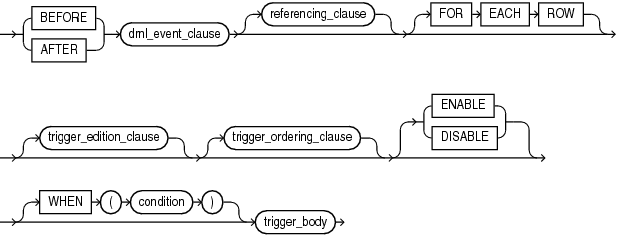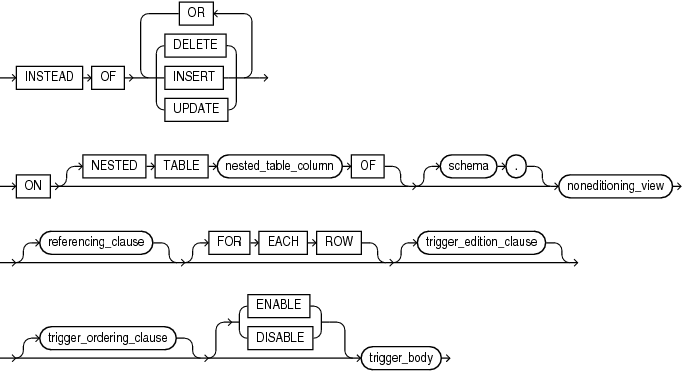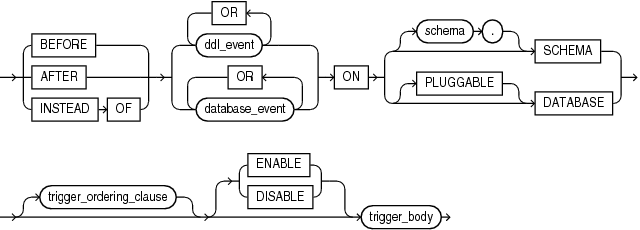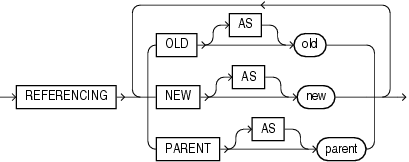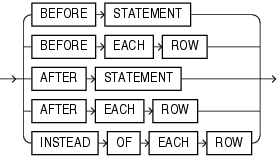15.12 CREATE TRIGGER Statement
The CREATE TRIGGER statement creates or replaces a database trigger, which is either of these:
-
A stored PL/SQL block associated with a table, a view, a schema, or the database
-
An anonymous PL/SQL block or an invocation of a procedure implemented in PL/SQL or Java
The database automatically runs a trigger when specified conditions occur.
Topics
Prerequisites
-
To create a trigger in your schema on a table in your schema or on your schema (
SCHEMA), you must have theCREATETRIGGERsystem privilege. -
To create a trigger in any schema on a table in any schema, or on another user's schema (
schema.SCHEMA), you must have theCREATEANYTRIGGERsystem privilege. -
In addition to the preceding privileges, to create a trigger on
DATABASE, you must have theADMINISTERDATABASETRIGGERsystem privilege. -
To create a trigger on a pluggable database (PDB), you must be connected to that PDB and have the
ADMINISTERDATABASETRIGGERsystem privilege. For information about PDBs, see Oracle Database Administrator's Guide. -
In addition to the preceding privileges, to create a crossedition trigger, you must be enabled for editions. For information about enabling editions for a user, see Oracle Database Development Guide.
If the trigger issues SQL statements or invokes procedures or functions, then the owner of the trigger must have the privileges necessary to perform these operations. These privileges must be granted directly to the owner rather than acquired through roles.
Syntax
create_trigger ::=
plsql_trigger_source ::=
( sharing_clause ::= , default_collation_clause ::= , compound_dml_trigger ::= , instead_of_dml_trigger ::= , system_trigger ::= )
simple_dml_trigger ::=
( dml_event_clause ::= , referencing_clause ::= , trigger_body ::= , trigger_edition_clause ::= , trigger_ordering_clause ::= )
instead_of_dml_trigger ::=
( referencing_clause ::= , trigger_body ::= , trigger_edition_clause ::= , trigger_ordering_clause ::= )
compound_dml_trigger ::=
( compound_trigger_block ::= , dml_event_clause ::= , referencing_clause ::= , trigger_edition_clause ::= , trigger_ordering_clause ::= )
system_trigger ::=
dml_event_clause ::=
referencing_clause ::=
trigger_edition_clause ::=
trigger_ordering_clause ::=
compound_trigger_block ::=
timing_point_section ::=
timing_point ::=
Semantics
create_trigger
OR REPLACE
Re-creates the trigger if it exists, and recompiles it.
Users who were granted privileges on the trigger before it was redefined can still access the procedure without being regranted the privileges.
[ EDITIONABLE | NONEDITIONABLE ]
Specifies whether the trigger is an editioned or noneditioned object if editioning is enabled for the schema object type TRIGGER in schema. Default: EDITIONABLE. For information about editioned and noneditioned objects, see Oracle Database Development Guide.
Restriction on NONEDITIONABLE
You cannot specify NONEDITIONABLE for a crossedition trigger.
Restrictions on create_trigger
See "Trigger Restrictions".
plsql_trigger_source
schema
Name of the schema for the trigger to be created. Default: your schema.
trigger
Name of the trigger to be created.
Triggers in the same schema cannot have the same names. Triggers can have the same names as other schema objects—for example, a table and a trigger can have the same name—however, to avoid confusion, this is not recommended.
If a trigger produces compilation errors, then it is still created, but it fails on execution. A trigger that fails on execution effectively blocks all triggering DML statements until it is disabled, replaced by a version without compilation errors, or dropped. You can see the associated compiler error messages with the SQL*Plus command SHOW ERRORS.
Note:
If you create a trigger on a base table of a materialized view, then you must ensure that the trigger does not fire during a refresh of the materialized view. During refresh, the DBMS_MVIEW procedure I_AM_A_REFRESH returns TRUE.
simple_dml_trigger
Creates a simple DML trigger (described in "DML Triggers").
BEFORE
Causes the database to fire the trigger before running the triggering event. For row triggers, the trigger fires before each affected row is changed.
Restrictions on BEFORE
-
You cannot specify a
BEFOREtrigger on a view unless it is an editioning view. -
In a
BEFOREstatement trigger, the trigger body cannot read:NEWor:OLD. (In aBEFORErow trigger, the trigger body can read and write the:OLDand:NEWfields.)
AFTER
Causes the database to fire the trigger after running the triggering event. For row triggers, the trigger fires after each affected row is changed.
Restrictions on AFTER
-
You cannot specify an
AFTERtrigger on a view unless it is an editioning view. -
In an
AFTERstatement trigger, the trigger body cannot read:NEWor:OLD. (In anAFTERrow trigger, the trigger body can read but not write the:OLDand:NEWfields.)
Note:
When you create a materialized view log for a table, the database implicitly creates an AFTER row trigger on the table. This trigger inserts a row into the materialized view log whenever an INSERT, UPDATE, or DELETE statement modifies data in the associated table. You cannot control the order in which multiple row triggers fire. Therefore, do not write triggers intended to affect the content of the materialized view.
See Also:
-
Oracle Database SQL Language Reference for more information about materialized view logs
-
Oracle Database Development Guide for information about editioning views
FOR EACH ROW
Creates the trigger as a row trigger. The database fires a row trigger for each row that is affected by the triggering statement and meets the optional trigger constraint defined in the WHEN condition.
If you omit this clause, then the trigger is a statement trigger. The database fires a statement trigger only when the triggering statement is issued if the optional trigger constraint is met.
[ ENABLE | DISABLE ]
Creates the trigger in an enabled (default) or disabled state. Creating a trigger in a disabled state lets you ensure that the trigger compiles without errors before you enable it.
Note:
DISABLE is especially useful if you are creating a crossedition trigger, which affects the online application being redefined if compilation errors occur.
WHEN (condition)
Specifies a SQL condition that the database evaluates for each row that the triggering statement affects. If the value of condition is TRUE for an affected row, then trigger_body runs for that row; otherwise, trigger_body does not run for that row. The triggering statement runs regardless of the value of condition.
The condition can contain correlation names (see "referencing_clause ::=").
In condition, do not put a colon (:) before the correlation name NEW, OLD, or PARENT (in this context, it is not a placeholder for a bind variable).
See Also:
Oracle Database SQL Language Reference for information about SQL conditions
Restrictions on WHEN (condition)
-
If you specify this clause, then you must also specify
FOREACHROW. -
The
conditioncannot include a subquery or a PL/SQL expression (for example, an invocation of a user-defined function).
trigger_body
The PL/SQL block or CALL subprogram that the database runs to fire the trigger. A CALL subprogram is either a PL/SQL subprogram or a Java subprogram in a PL/SQL wrapper.
If trigger_body is a PL/SQL block and it contains errors, then the CREATE [OR REPLACE] statement fails.
Restriction on trigger_body
The declare_section cannot declare variables of the data type LONG or LONG RAW.
instead_of_dml_trigger
Creates an INSTEAD OF DML trigger (described in "INSTEAD OF DML Triggers").
Restriction on INSTEAD OF
An INSTEAD OF trigger can read the :OLD and :NEW values, but cannot change them.
Note:
-
If the view is inherently updatable and has
INSTEADOFtriggers, the triggers take precedence: The database fires the triggers instead of performing DML on the view. -
If the view belongs to a hierarchy, then the subviews do not inherit the trigger.
-
The
WITHCHECKOPTIONfor views is not enforced when inserts or updates to the view are done usingINSTEADOFtriggers. TheINSTEADOFtrigger body must enforce the check. For information aboutWITHCHECKOPTION, see Oracle Database SQL Language Reference. -
The database fine-grained access control lets you define row-level security policies on views. These policies enforce specified rules in response to DML operations. If an
INSTEADOFtrigger is also defined on the view, then the database does not enforce the row-level security policies, because the database fires theINSTEADOFtrigger instead of running the DML on the view.
DELETE
If the trigger is created on a noneditioning view, then DELETE causes the database to fire the trigger whenever a DELETE statement removes a row from the table on which the noneditioning view is defined.
If the trigger is created on a nested table column of a noneditioning view, then DELETE causes the database to fire the trigger whenever a DELETE statement removes an element from the nested table.
INSERT
If the trigger is created on a noneditioning view, then INSERT causes the database to fire the trigger whenever an INSERT statement adds a row to the table on which the noneditioning view is defined.
If the trigger is created on a nested table column of a noneditioning view, then INSERT causes the database to fire the trigger whenever an INSERT statement adds an element to the nested table.
UPDATE
If the trigger is created on a noneditioning view, then UPDATE causes the database to fire the trigger whenever an UPDATE statement changes a value in a column of the table on which the noneditioning view is defined.
If the trigger is created on a nested table column of a noneditioning view, then UPDATE causes the database to fire the trigger whenever an UPDATE statement changes a value in a column of the nested table.
nested_table_column
Name of the nested_table_column on which the trigger is to be created. The trigger fires only if the DML operates on the elements of the nested table. Performing DML operations directly on nested table columns does not cause the database to fire triggers defined on the table containing the nested table column. For more information, see "INSTEAD OF DML Triggers".
See Also:
AS subquery clause of CREATE VIEW in Oracle Database SQL Language Reference for a list of constructs that prevent inserts, updates, or deletes on a view
schema
Name of the schema containing the noneditioning view. Default: your schema.
noneditioning_view
If you specify nested_table_column, then noneditioning_view is the name of the noneditioning view that includes nested_table_column. Otherwise, noneditioning_view is the name of the noneditioning view on which the trigger is to be created.
FOR EACH ROW
For documentation only, because an INSTEAD OF trigger is always a row trigger.
ENABLE
(Default) Creates the trigger in an enabled state.
DISABLE
Creates the trigger in a disabled state, which lets you ensure that the trigger compiles without errors before you enable it.
Note:
DISABLE is especially useful if you are creating a crossedition trigger, which affects the online application being redefined if compilation errors occur.
trigger_body
The PL/SQL block or CALL subprogram that the database runs to fire the trigger. A CALL subprogram is either a PL/SQL subprogram or a Java subprogram in a PL/SQL wrapper.
If trigger_body is a PL/SQL block and it contains errors, then the CREATE [OR REPLACE] statement fails.
Restriction on trigger_body
The declare_section cannot declare variables of the data type LONG or LONG RAW.
compound_dml_trigger
Creates a compound DML trigger (described in "Compound DML Triggers").
ENABLE
(Default) Creates the trigger in an enabled state.
DISABLE
Creates the trigger in a disabled state, which lets you ensure that the trigger compiles without errors before you enable it.
Note:
DISABLE is especially useful if you are creating a crossedition trigger, which affects the online application being redefined if compilation errors occur.
WHEN (condition)
Specifies a SQL condition that the database evaluates for each row that the triggering statement affects. If the value of condition is TRUE for an affected row, then tps_body runs for that row; otherwise, tps_body does not run for that row. The triggering statement runs regardless of the value of condition.
The condition can contain correlation names (see "referencing_clause ::="). In condition, do not put a colon (:) before the correlation name NEW, OLD, or PARENT (in this context, it is not a placeholder for a bind variable).
See Also:
Oracle Database SQL Language Reference for information about SQL conditions
Restrictions on WHEN (condition)
-
If you specify this clause, then you must also specify at least one of these timing points:
-
BEFOREEACHROW -
AFTEREACHROW -
INSTEADOFEACHROW
-
-
The
conditioncannot include a subquery or a PL/SQL expression (for example, an invocation of a user-defined function).
system_trigger
Defines a system trigger (described in "System Triggers").
BEFORE
Causes the database to fire the trigger before running the triggering event.
AFTER
Causes the database to fire the trigger after running the triggering event.
INSTEAD OF
Creates an INSTEAD OF trigger.
Restrictions on INSTEAD OF
-
The triggering event must be a
CREATEstatement. -
You can create at most one
INSTEADOFDDL trigger (non_dml_trigger).For example, you can create an
INSTEADOFtrigger on either the database or schema, but not on both the database and schema.
ddl_event
One or more types of DDL SQL statements that can cause the trigger to fire.
You can create triggers for these events on DATABASE or SCHEMA unless otherwise noted. You can create BEFORE and AFTER triggers for any of these events, but you can create INSTEAD OF triggers only for CREATE events. The database fires the trigger in the existing user transaction.
Note:
Some objects are created, altered, and dropped using PL/SQL APIs (for example, scheduler jobs are maintained by subprograms in the DBMS_SCHEDULER package). Such PL/SQL subprograms do not fire DDL triggers.
The following ddl_event values are valid:
-
ALTERCauses the database to fire the trigger whenever an
ALTERstatement modifies a database object in the data dictionary. AnALTERDATABASEstatement does not fire the trigger. -
ANALYZECauses the database to fire the trigger whenever the database collects or deletes statistics or validates the structure of a database object.
See Also:
Oracle Database SQL Language Reference for information about using the SQL statement
ANALYZEto collect statistics -
ASSOCIATESTATISTICSCauses the database to fire the trigger whenever the database associates a statistics type with a database object.
-
AUDITCauses the database to fire the trigger whenever an
AUDITstatement is issued. -
COMMENTCauses the database to fire the trigger whenever a comment on a database object is added to the data dictionary.
-
CREATECauses the database to fire the trigger whenever a
CREATEstatement adds a database object to the data dictionary. TheCREATEDATABASEorCREATECONTROLFILEstatement does not fire the trigger. -
DISASSOCIATESTATISTICSCauses the database to fire the trigger whenever the database disassociates a statistics type from a database object.
-
DROPCauses the database to fire the trigger whenever a
DROPstatement removes a database object from the data dictionary. -
GRANTCauses the database to fire the trigger whenever a user grants system privileges or roles or object privileges to another user or to a role.
-
NOAUDITCauses the database to fire the trigger whenever a
NOAUDITstatement is issued. -
RENAMECauses the database to fire the trigger whenever a
RENAMEstatement changes the name of a database object. -
REVOKECauses the database to fire the trigger whenever a
REVOKEstatement removes system privileges or roles or object privileges from a user or role. -
TRUNCATECauses the database to fire the trigger whenever a
TRUNCATEstatement removes the rows from a table or cluster and resets its storage characteristics. -
DDLCauses the database to fire the trigger whenever any of the preceding DDL statements is issued.
database_event
One of the following database events. You can create triggers for these events on either DATABASE or SCHEMA unless otherwise noted. For each of these triggering events, the database opens an autonomous transaction scope, fires the trigger, and commits any separate transaction (regardless of any existing user transaction).
-
AFTERSTARTUPCauses the database to fire the trigger whenever the database is opened. This event is valid only with
DATABASE, not withSCHEMA. -
BEFORESHUTDOWNCauses the database to fire the trigger whenever an instance of the database is shut down. This event is valid only with
DATABASE, not withSCHEMA. -
AFTERDB_ROLE_CHANGEIn an Oracle Data Guard configuration, causes the database to fire the trigger whenever a role change occurs from standby to primary or from primary to standby. This event is valid only with
DATABASE, not withSCHEMA.Note:
You cannot create an
AFTERDB_ROLE_CHANGEtrigger on a PDB. -
AFTERSERVERERRORCauses the database to fire the trigger whenever both of these conditions are true:
-
A server error message is logged.
-
Oracle relational database management system (RDBMS) determines that it is safe to fire error triggers.
Examples of when it is unsafe to fire error triggers include:
-
RDBMS is starting up.
-
A critical error has occurred.
-
-
-
AFTERLOGONCauses the database to fire the trigger whenever a client application logs onto the database.
-
BEFORELOGOFFCauses the database to fire the trigger whenever a client application logs off the database.
-
AFTERSUSPENDCauses the database to fire the trigger whenever a server error causes a transaction to be suspended.
-
AFTERCLONECan be specified only if
PLUGGABLEDATABASEis specified. After the PDB is copied (cloned), the database fires the trigger in the new PDB and then deletes the trigger. If the trigger fails, then the copy operation fails. -
BEFOREUNPLUGCan be specified only if
PLUGGABLEDATABASEis specified. Before the PDB is unplugged, the database fires the trigger and then deletes it. If the trigger fails, then the unplug operation fails. -
[
BEFORE|AFTER]SETCONTAINERCauses the database to fire the trigger either before or after an
ALTERSESSIONSETCONTAINERstatement executes.
See Also:
"Triggers for Publishing Events" for more information about responding to database events through triggers
[schema.]SCHEMA
Defines the trigger on the specified schema. Default: current schema. The trigger fires whenever any user connected as the specified schema initiates the triggering event.
[ PLUGGABLE ] DATABASE
DATABASE defines the trigger on the root. In a multitenant container database (CDB), only a common user who is connected to the root can create a trigger on the entire database.
PLUGGABLE DATABASE defines the trigger on the PDB to which you are connected.
The trigger fires whenever any user of the specified database or PDB initiates the triggering event.
Note:
If you are connected to a PDB, then specifying DATABASE is equivalent to specifying PLUGGABLE DATABASE unless you want to specify an option that applies only to a PDB (such as CLONE or UNPLUG).
ENABLE
(Default) Creates the trigger in an enabled state.
DISABLE
Creates the trigger in a disabled state, which lets you ensure that the trigger compiles without errors before you enable it.
WHEN (condition)
Specifies a SQL condition that the database evaluates. If the value of condition is TRUE, then trigger_body runs for that row; otherwise, trigger_body does not run for that row. The triggering statement runs regardless of the value of condition.
See Also:
Oracle Database SQL Language Reference for information about SQL conditions
Restrictions on WHEN (condition)
-
You cannot specify this clause for a
STARTUP,SHUTDOWN, orDB_ROLE_CHANGEtrigger. -
If you specify this clause for a
SERVERERRORtrigger, thenconditionmust beERRNO=error_code. -
The
conditioncannot include a subquery, a PL/SQL expression (for example, an invocation of a user-defined function), or a correlation name.
trigger_body
The PL/SQL block or CALL subprogram that the database runs to fire the trigger. A CALL subprogram is either a PL/SQL subprogram or a Java subprogram in a PL/SQL wrapper.
If trigger_body is a PL/SQL block and it contains errors, then the CREATE [OR REPLACE] statement fails.
Restrictions on trigger_body
-
The
declare_sectioncannot declare variables of the data typeLONGorLONGRAW. -
The trigger body cannot specify either
:NEWor:OLD.
dml_event_clause
Specifies the triggering statements for simple_dml_trigger or compound_dml_trigger. The database fires the trigger in the existing user transaction.
DELETE
Causes the database to fire the trigger whenever a DELETE statement removes a row from table or the table on which view is defined.
INSERT
Causes the database to fire the trigger whenever an INSERT statement adds a row to table or the table on which view is defined.
UPDATE [ OF column [, column ] ]
Causes the database to fire the trigger whenever an UPDATE statement changes a value in a specified column. Default: The database fires the trigger whenever an UPDATE statement changes a value in any column of table or the table on which view is defined.
If you specify a column, then you cannot change its value in the body of the trigger.
schema
Name of the schema that contains the database object on which the trigger is to be created. Default: your schema.
table
Name of the database table or object table on which the trigger is to be created.
Restriction on schema.table
You cannot create a trigger on a table in the schema SYS.
view
Name of the database view or object view on which the trigger is to be created.
Note:
A compound DML trigger created on a noneditioning view is not really compound, because it has only one timing point section.
referencing_clause
Specifies correlation names, which refer to old, new, and parent values of the current row. Defaults: OLD, NEW, and PARENT.
If your trigger is associated with a table named OLD, NEW, or PARENT, then use this clause to specify different correlation names to avoid confusion between the table names and the correlation names.
If the trigger is defined on a nested table, then OLD and NEW refer to the current row of the nested table, and PARENT refers to the current row of the parent table. If the trigger is defined on a database table or view, then OLD and NEW refer to the current row of the database table or view, and PARENT is undefined.
Restriction on referencing_clause
The referencing_clause is not valid if trigger_body is CALL routine.
DML row-level triggers cannot reference fields of OLD/NEW/PARENT pseudorecords (correlation names) that correspond to columns with declared collation other than USING_NLS_COMP.
trigger_edition_clause
Creates the trigger as a crossedition trigger.
The handling of DML changes during edition-based redefinition (EBR) of an online application can entail multiple steps. Therefore, it is likely, though not required, that a crossedition trigger is also a compound trigger.
Restrictions on trigger_edition_clause
-
You cannot define a crossedition trigger on a view.
-
You cannot specify
NONEDITIONABLEfor a crossedition trigger.
FORWARD
(Default) Creates the trigger as a forward crossedition trigger. A forward crossedition trigger is intended to fire when DML changes are made in a database while an online application that uses the database is being patched or upgraded with EBR. The body of a crossedition trigger is designed to handle these DML changes so that they can be appropriately applied after the changes to the application code are completed.
REVERSE
Creates the trigger as a reverse crossedition trigger, which is intended to fire when the application, after being patched or upgraded with EBR, makes DML changes. This trigger propagates data to columns or tables used by the application before it was patched or upgraded.
See Also:
Oracle Database Development Guide for more information crossedition triggers
trigger_ordering_clause
FOLLOWS | PRECEDES
Specifies the relative firing of triggers that have the same timing point. It is especially useful when creating crossedition triggers, which must fire in a specific order to achieve their purpose.
Use FOLLOWS to indicate that the trigger being created must fire after the specified triggers. You can specify FOLLOWS for a conventional trigger or for a forward crossedition trigger.
Use PRECEDES to indicate that the trigger being created must fire before the specified triggers. You can specify PRECEDES only for a reverse crossedition trigger.
The specified triggers must exist, and they must have been successfully compiled. They need not be enabled.
If you are creating a noncrossedition trigger, then the specified triggers must be all of the following:
-
Noncrossedition triggers
-
Defined on the same table as the trigger being created
-
Visible in the same edition as the trigger being created
If you are creating a crossedition trigger, then the specified triggers must be all of the following:
-
Crossedition triggers
-
Defined on the same table or editioning view as the trigger being created, unless you specify
FOLLOWSorPRECEDES.If you specify
FOLLOWS, then the specified triggers must be forward crossedition triggers, and if you specifyPRECEDES, then the specified triggers must be reverse crossedition triggers. However, the specified triggers need not be on the same table or editioning view as the trigger being created. -
Visible in the same edition as the trigger being created
In the following definitions, A, B, C, and D are either noncrossedition triggers or forward crossedition triggers:
-
If B specifies A in its
FOLLOWSclause, then B directly follows A. -
If C directly follows B, and B directly follows A, then C indirectly follows A.
-
If D directly follows C, and C indirectly follows A, then D indirectly follows A.
-
If B directly or indirectly follows A, then B explicitly follows A (that is, the firing order of B and A is explicitly specified by one or more
FOLLOWSclauses).
In the following definitions, A, B, C, and D are reverse crossedition triggers:
-
If A specifies B in its
PRECEDESclause, then A directly precedes B. -
If A directly precedes B, and B directly precedes C, then A indirectly precedes C.
-
If A directly precedes B, and B indirectly precedes D, then A indirectly precedes D.
-
If A directly or indirectly precedes B, then A explicitly precedes B (that is, the firing order of A and B is explicitly specified by one or more
PRECEDESclauses).
Belongs to compound_dml_trigger.
compound_trigger_block
If the trigger is created on a noneditioning view, then compound_trigger_block must have only the INSTEAD OF EACH ROW section.
If the trigger is created on a table or editioning view, then timing point sections can be in any order, but no section can be repeated. The compound_trigger_block cannot have an INSTEAD OF EACH ROW section.
See Also:
Restriction on compound_trigger_block
The declare_section of compound_trigger_block cannot include PRAGMA AUTONOMOUS_TRANSACTION.
See Also:
timing_point
BEFORE STATEMENT
Specifies the BEFORE STATEMENT section of a compound_dml_trigger on a table or editioning view. This section causes the database to fire the trigger before running the triggering event.
Restriction on BEFORE STATEMENT
This section cannot specify :NEW or :OLD.
BEFORE EACH ROW
Specifies the BEFORE EACH ROW section of a compound_dml_trigger on a table or editioning view. This section causes the database to fire the trigger before running the triggering event. The trigger fires before each affected row is changed.
This section can read and write the :OLD and :NEW fields.
AFTER STATEMENT
Specifies the AFTER STATEMENT section of compound_dml_trigger on a table or editioning view. This section causes the database to fire the trigger after running the triggering event.
Restriction on AFTER STATEMENT
This section cannot specify :NEW or :OLD.
AFTER EACH ROW
Specifies the AFTER EACH ROW section of a compound_dml_trigger on a table or editioning view. This section causes the database to fire the trigger after running the triggering event. The trigger fires after each affected row is changed.
This section can read but not write the :OLD and :NEW fields.
INSTEAD OF EACH ROW
Specifies the INSTEAD OF EACH ROW section (the only timing point section) of a compound_dml_trigger on a noneditioning view. The database runs tps_body instead of running the triggering DML statement. For more information, see "INSTEAD OF DML Triggers".
Restriction on INSTEAD OF EACH ROW
-
This section can appear only in a
compound_dml_triggeron a noneditioning view. -
This section can read but not write the
:OLDand:NEWvalues.
tps_body
The PL/SQL block or CALL subprogram that the database runs to fire the trigger. A CALL subprogram is either a PL/SQL subprogram or a Java subprogram in a PL/SQL wrapper.
If tps_body is a PL/SQL block and it contains errors, then the CREATE [OR REPLACE] statement fails.
Restriction on tps_body
The declare_section cannot declare variables of the data type LONG or LONG RAW.
Examples
DML Triggers
-
Example 10-1, "Trigger Uses Conditional Predicates to Detect Triggering Statement"
-
Example 10-2, "INSTEAD OF Trigger"
-
Example 10-3, "INSTEAD OF Trigger on Nested Table Column of View"
-
Example 10-4, "Compound Trigger Logs Changes to One Table in Another Table"
-
Example 10-5, "Compound Trigger Avoids Mutating-Table Error"
Triggers for Ensuring Referencial Integrity
-
Example 10-6, "Foreign Key Trigger for Child Table"
-
Example 10-7, "UPDATE and DELETE RESTRICT Trigger for Parent Table"
-
Example 10-8, "UPDATE and DELETE SET NULL Trigger for Parent Table"
-
Example 10-9, "DELETE CASCADE Trigger for Parent Table"
-
Example 10-10, "UPDATE CASCADE Trigger for Parent Table"
-
Example 10-11, "Trigger Checks Complex Constraints"
-
Example 10-12, "Trigger Enforces Security Authorizations"
-
Example 10-13, "Trigger Derives New Column Values"
Triggers That Use Correlation Names and Pseudorecords
-
Example 10-14, "Trigger Logs Changes to EMPLOYEES.SALARY"
-
Example 10-15, "Conditional Trigger Prints Salary Change Information"
-
Example 10-16, "Trigger Modifies CLOB Columns"
-
Example 10-17, "Trigger with REFERENCING Clause"
-
Example 10-18, "Trigger References OBJECT_VALUE Pseudocolumn"
System Triggers
-
Example 10-19, "BEFORE Statement Trigger on Sample Schema HR"
-
Example 10-20, "AFTER Statement Trigger on Database"
-
Example 10-21, "Trigger Monitors Logons"
-
Example 10-22, "INSTEAD OF CREATE Trigger on Schema"
Miscellaneous Trigger Examples
-
Example 10-23, "Trigger Invokes Java Subprogram"
-
Example 10-24, "Trigger Cannot Handle Exception if Remote Database is Unavailable"
-
Example 10-25, "Workaround for Trigger Cannot Handle Exception if Remote Database is Unavailable"
-
Example 10-26, "Trigger Causes Mutating-Table Error"
-
Example 10-27, "Update Cascade"
-
Example 10-28, "Viewing Information About Triggers"
Related Topics
In this chapter:
In other chapters:
See Also:
Oracle Database Development Guide for more information about crossedition triggers


